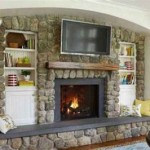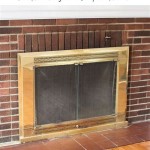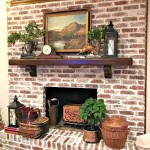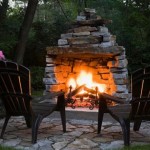How to Paint a Metal Fireplace Cover
A metal fireplace cover, while functional in preventing sparks and embers from escaping, can become an eyesore over time. Exposure to heat, soot, and general wear and tear can lead to rust, discoloration, and a generally unappealing aesthetic. Fortunately, painting a metal fireplace cover is a straightforward and cost-effective way to revitalize its appearance and seamlessly integrate it into the surrounding decor. This article provides a comprehensive guide to properly preparing and painting a metal fireplace cover, ensuring a durable and aesthetically pleasing finish.
Key Point 1: Preparation is Paramount - Cleaning and Rust Removal
The success of any paint job, especially one dealing with metal and high heat, hinges on proper preparation. Neglecting this crucial step can lead to peeling paint, poor adhesion, and a less-than-desirable finished product. The preparation process involves thorough cleaning, rust removal (if applicable), and surface priming.
The initial step is to detach the fireplace cover from the fireplace opening. Ensure the fireplace is cool before attempting to remove the cover. Once removed, take the cover to a well-ventilated area, preferably outdoors or in a garage with open doors and windows. Lay down a drop cloth to protect the work surface from paint and debris.
Begin by cleaning the surface of the fireplace cover. Use a stiff-bristled brush, such as a wire brush or a nylon scrub brush, to remove loose soot, dust, and debris. For stubborn deposits, a solution of warm water and mild detergent can be used. Apply the solution with a sponge or cloth, scrubbing the affected areas gently but firmly. Rinse the cover thoroughly with clean water and allow it to dry completely before proceeding to the next step.
Inspect the cover for any signs of rust. Rust is a common problem with metal fireplace covers, especially those that have been exposed to moisture. If rust is present, it must be removed before painting. Small patches of rust can be removed with sandpaper. Use a medium-grit sandpaper (around 120-grit) to sand away the rust, working in circular motions. For larger areas of rust, a wire brush or a power drill with a wire brush attachment may be necessary. Be sure to wear appropriate safety gear, including eye protection and a dust mask, when working with power tools and rust particles.
After removing the rust, smooth the surface with fine-grit sandpaper (around 220-grit) to create a uniform texture. This will help the primer and paint adhere properly. Wipe the cover clean with a tack cloth to remove any sanding dust before moving to the priming stage.
If the fireplace cover has existing paint that is peeling or chipping, it should be removed before applying a new coat. A paint scraper can be used to remove loose paint. For stubborn paint, a chemical paint stripper may be necessary. Follow the manufacturer’s instructions carefully when using paint stripper, and be sure to wear appropriate protective gear, including gloves and eye protection. After removing the paint, clean the surface thoroughly and allow it to dry completely.
Key Point 2: Selecting the Right Primer and Paint
Choosing the appropriate primer and paint is crucial for achieving a durable and heat-resistant finish. Not all paints are created equal, especially when dealing with the high temperatures generated by a fireplace. Selecting the wrong paint can lead to blistering, peeling, and the release of potentially harmful fumes.
First, apply a primer specifically designed for metal surfaces. A self-etching primer is highly recommended. This type of primer contains an etching agent that bites into the metal surface, creating a strong bond. This is particularly important for surfaces that have been sanded or have previously had rust removed. Apply the primer in thin, even coats, following the manufacturer's instructions on the can. Allow the primer to dry completely before proceeding to the painting stage.
Next, select a high-heat paint specifically formulated for use on fireplaces, stoves, or other surfaces exposed to elevated temperatures. These paints are typically available in aerosol cans or liquid form. Aerosol cans are generally easier to use for smaller projects, while liquid paints are better suited for larger surfaces or when a specific color match is required.
High-heat paints are available in a variety of colors and finishes, including matte, satin, and gloss. Matte finishes are generally more resistant to showing fingerprints and smudges, while gloss finishes are easier to clean. Consider the overall aesthetic of the room and the desired effect when choosing a finish.
Read the labels carefully to ensure that the chosen paint is rated for the appropriate temperature. Fireplace covers can reach temperatures of several hundred degrees Fahrenheit, so selecting a paint that can withstand these temperatures is essential. Choose a paint specifically rated for temperatures exceeding the maximum expected temperature of the fireplace cover to ensure durability and longevity.
Consider the volatile organic compound (VOC) content of the paint. VOCs are chemicals that can be released into the air during and after painting. High-VOC paints can contribute to air pollution and can be harmful to human health. Look for low-VOC or zero-VOC paints whenever possible to minimize environmental impact and ensure a safer working environment.
When purchasing paint, it is also advisable to purchase a compatible high-heat primer from the same manufacturer. Using a compatible primer ensures optimal adhesion and prevents potential compatibility issues between the primer and the paint.
Key Point 3: Applying the Paint and Ensuring a Durable Finish
With proper preparation completed and the correct primer and paint selected, the final step involves applying the paint and taking measures to ensure a durable and long-lasting finish. The application technique significantly impacts the final appearance and resistance to wear and tear.
Before applying the paint, ensure the primed surface is clean and free of dust and debris. Use a tack cloth to wipe down the surface one last time. If using spray paint, shake the can vigorously for at least one minute to ensure the paint is properly mixed.
Apply the paint in thin, even coats, holding the spray can approximately 10-12 inches from the surface. Overlapping each stroke slightly helps to prevent streaks and ensure even coverage. Applying multiple thin coats is preferable to applying one thick coat, as thick coats are more prone to running and dripping.
If using liquid paint, apply it with a high-quality brush specifically designed for use with the chosen paint type. Use long, even strokes to apply the paint, overlapping each stroke slightly. Avoid applying too much paint at once, as this can lead to drips and runs. Work in small sections at a time to maintain control over the application process.
Allow each coat of paint to dry completely before applying the next coat. The drying time will vary depending on the type of paint used and the ambient temperature and humidity. Consult the manufacturer's instructions for specific drying times.
Apply at least two coats of paint to ensure adequate coverage and durability. For high-wear areas, such as the edges of the fireplace cover, consider applying a third coat for added protection.
After the final coat of paint has dried completely, allow the fireplace cover to cure for several days before exposing it to heat. Curing allows the paint to fully harden and bond to the metal surface, increasing its resistance to chipping, peeling, and blistering. Consult the manufacturer's instructions for specific curing times.
Once the paint has fully cured, the fireplace cover can be reattached to the fireplace opening. Handle the cover with care to avoid scratching or damaging the new paint finish. Regularly clean the fireplace cover to remove soot and dust, which can accumulate over time and dull the finish. Use a soft cloth and mild detergent to clean the surface, avoiding abrasive cleaners or scouring pads that can scratch the paint.
By following these steps, individuals can effectively paint a metal fireplace cover, enhancing its aesthetic appeal and extending its lifespan. Proper preparation, the selection of high-quality materials, and careful application are key to achieving a durable and visually pleasing result that will enhance the overall ambiance of the living space.

Fireplace Door Update With Spray Paint Roots Wings Furniture Llc

How To Spray Paint A Brass Fireplace Insert Erfly House

How To Paint Metal Fireplace Surround Four Generations One Roof

Fireplace Door Update With Spray Paint Roots Wings Furniture Llc

How To Spray Paint A Brass Fireplace Bright Green Door

How To Spray Paint A Brass Fireplace Insert Erfly House

How To Paint Metal Fireplace Surround Four Generations One Roof Surrounds Home Remodeling Makeover

How To Paint Metal Fireplace Surround Four Generations One Roof

How To Update Fireplace Brass

Brass Fireplace Makeover Brick Remodel Home








